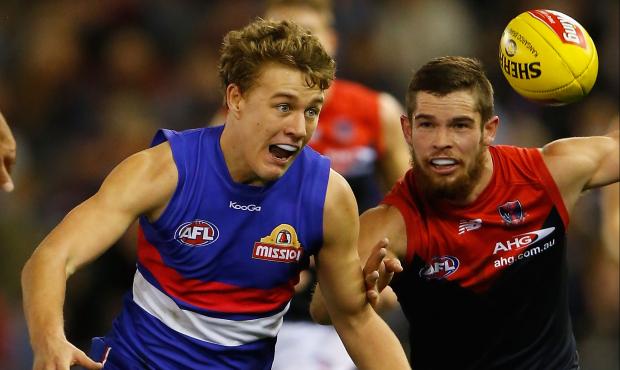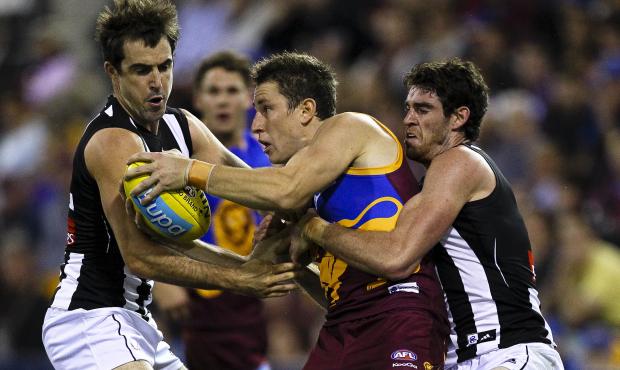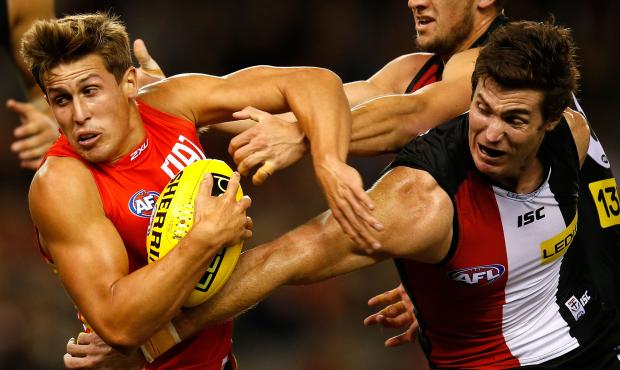CARLTON | | CLUB | AFL AVERAGE |
|---|
| Running bounces | 13.8 (2nd) | 9.7 |
| Clearances to score % | 27.0% (4th) | 24.4% |
Any team that boasts the scintillating speed, evasive skills and boundless confidence of a player like Chris Yarran is going to rank highly when it comes to running bounces. The Blues rank second in the AFL, with Yarran contributing a competition-high of 3.2 per game. And he is complemented in this area by fellow gallopers like Kade Simpson, Marc Murphy, Andrew Walker, Andrejs Everitt and Dale Thomas. This willingness to take on the game was one perhaps of the factors in Carlton also being fourth-best at scoring from clearances. When recently-crowned club champion Bryce Gibbs, Murphy and veteran Chris Judd take possession around a stoppage, good things usually happen. And they might happen more regularly for the Blues, who are trying to evolve and expand their midfield.
– Ben Collins
COLLINGWOOD | | CLUB | AFL AVERAGE |
|---|
| Tackles | 71.1 (2nd) | 66.5 |
| Accuracy from snap shots | 59.8% (3rd) | 53.0% |
When the Magpies pushed into the top four earlier this year it was their tackling pressure that was the club's trademark. Tyson Goldsack and Jarryd Blair both thrived in applying pressure up forward, while captain Scott Pendlebury took out the Gavin Brown Award for leading desire indicators and amassed 116 tackles through the season. Collingwood also made a point of working on their accuracy in front of goal. The Magpies were a bit hit and miss from set shots, but executed well from snap shots. Jamie Elliott, Blair and even Travis Cloke are reliable exponents of the skill.
– Ben Guthrie
Tyson Goldsack's (right) forward pressure was a highlight for the Magpies. Picture: AFL Media
ESSENDON | | CLUB | AFL AVERAGE |
|---|
| Disposal efficiency % | 74.1% (1st) | 72.3% |
| D50 to In50 conversion | 27.1% (1st) | 22.2% |
The Bombers followed a plan to hold possession of the ball last season, meaning they were able to chip it around before making a bolder move to whisk it down the ground. It meant the club's disposal efficiency was very good – the best in the competition at 74.1 per cent. The AFL average was 72.3 per cent. Sometimes it didn't quite work to plan though, as stand-in Bombers coach Mark Thompson occasionally bemoaned his side would become too 'safe' with its ball movement. Essendon also topped the competition for converting defensive inside-50 entries into attacking inside-50 entries, another example of its ability to work the ball down the ground.
– Callum Twomey
FREMANTLE | | CLUB | AFL AVERAGE |
|---|
| Points from turnovers - differential | +13.0pts (3rd) | N/A |
| In50 to goal % | 26.9% (2nd) | 25.0% |
Each of these statistics is a consequence of Ross Lyon's philosophy of team pressure and team defence. Fremantle is the third best side in the AFL for points from turnover differential, meaning the Dockers score more from turnovers than their opposition on a weekly basis. The Dockers pride themselves on midfield turnovers. It is a stat Ross Lyon often talks about because it is easier to score in transition having reclaimed the ball in the midfield than if you create turnovers in the defensive 50. With the high midfield turnovers due to the pressure of their forwards the Dockers have a high inside 50 to goal percentage. They are ranked second in the AFL in that category because opponents do not have a chance to set up a defensive structure to stop scores if they have turned the ball over in the midfield. The Dockers forwards have space and time to work with and score freely from entries as a result. –
Alex Malcolm
GEELONG | | CLUB | AFL AVERAGE |
|---|
| Clearance to score % | 29.5% (1st) | 24.4% |
| Marks inside 50 | 14.0 (1st) | 11.0 |
Geelong's spread from the contest is highly regarded, so there is little surprise the club was placed No.1 in the AFL in regard to converting clearance wins into scores in 2014. Once they won the ball, the Cats were sharp in their movement and utilised the 'Geelong highway' to great effect as the quickest route towards goal. Once the ball found its way into the forward line, the pure marking power of spearhead Tom Hawkins, who led the AFL for marks inside 50 (97), gave the Cats a definitive target. Jimmy Bartel (31) and Joel Selwood (21) were also utilised, given their tremendous ability to win one-on-one marking contests.
– Ben Guthrie
GOLD COAST | | CLUB | AFL AVERAGE |
|---|
| Points differential Q1 – first 10 mins | +64 (3rd) | N/A |
| Hard-ball gets differential | +3.9 (3rd) | N/A |
It's not surprising the Suns are ranked so high in hard-ball gets when you have a look at their midfield personnel. David Swallow is arguably one of the most combative footballers in the League, while Jaeger O'Meara and Dion Prestia have never taken a backward step. And then there's Gary Ablett. It's set to become more of a strength in 2015 with
the addition of Hawk Mitch Hallahan and an extra 12 months experience into the largely youthful list. They also jumped opponents quickly and were ranked third for points differential in the opening 10 minutes of matches.
– Michael Whiting
David Swallow is a key part of Gold Coast's inside midfield rotation. Picture: AFL Media
GREATER WESTERN SYDNEY | | CLUB | AFL AVERAGE |
|---|
| Forward half clearance to score % | 45.2% (1st) | 38.2% |
| Tackle differential | +10.0 (1st) | N/A |
During Greater Western Sydney's best month of football in 2014, when it pushed Hawthorn and Essendon before defeating the Brisbane Lions and Carlton, its tackle differential shot to a positive of 15 a game. It is, says GWS captain Callan Ward, no surprise that when the Giants win the tackle and contested possession count, they win the game. It is a feather in the cap for such a young team to win the 'grunt' statistic of tackling and points to a bright future. With such class in the Giants' line-up, it's no wonder they can regularly turn forward clearances into scores but if GWS can consistently out-tackle opponents, it will become dangerous.
– Peter Ryan
HAWTHORN | | CLUB | AFL AVERAGE |
|---|
| In50 to Goal% | 30.1% (1st) | 25.0% |
| Scoring accuracy | 64.7% (1st) | 58.3% |
One of the Hawks' key strengths in 2014 was their ability to hit targets in good scoring positions inside the forward 50. Jarryd Roughead and Jack Gunston are notably strong in set-shot kicking but their job was made easier by the efficient fashion their teammates – like Liam Shiels, Bradley Hill, Isaac Smith and Jordan Lewis – delivered the ball to them. While poorer teams tended to kick and hope, the well-drilled Hawks made sure their entries counted.
– Jennifer Phelan
MELBOURNE | | CLUB | AFL AVERAGE |
|---|
| Disposal efficiency % | 73.8% (4th) | 72.3% |
Marks inside 50 - conceded
| 10.5 (7th) | 11.0 |
There is still not a lot for the Demons to hang their hats on when it comes to statistical indicators. Their ability to restrict the opposition from marking inside 50 shows they were well organised, able to put defensive pressure on the opposition midfield and competitive in the air. However to really worry opponents, Melbourne needs to be able to take intercept marks and rebound quickly. It does have a good disposal efficiency but the eye would suggest several reasons for that. One is Jack Watts, who is an excellent user of the ball, but another could be the team's tendency to take safe kicks, therefore hitting the target without necessarily piercing the opposition's defence. The Demons remain a work in progress but they certainly have become a team that is harder to score against under Paul Roos.
– Peter Ryan
NORTH MELBOURNE | | CLUB | AFL AVERAGE |
|---|
| In50 to score % - against | 44.2% (3rd) | 47.6% |
| In50 to score % - for | 51.9% (1st) | 47.6% |
North became a much better defensive team in 2014, conceding the fifth fewest points in the competition. The Roos' strong defensive focus was reflected in their ability to stop opponents from scoring from inside 50 entries. North ranked third in the competition in this statistic, conceding a score just 44.2 per cent of the time. North's new defensive mindset came at a cost, with its average score dropping by almost 13 points a game this year (from 104.9 points in 2013 to 92.1). However, North's attack was still potent, with the Roos scoring from inside 50 entries more often than any other team (51.9 per cent).
– Nick Bowen
PORT ADELAIDE | | CLUB | AFL AVERAGE |
|---|
| Inside 50s | 56.5 (1st) | 47.6% |
| Clearance to score % | 28.0% (2nd) | 24.3% |
Boasting one of the AFL's premier midfields, it should come of no surprise that the Power averaged more inside-50s than any other side. With skipper Travis Boak firing alongside his deputies Brad Ebert, Ollie Wines, Jared Polec and speedster Matt White, Port's engine room provided its forwards with great attacking entry. Ruckman Matthew Lobbe was also in top form in 2014 and helped the midfielders to shine as much as they did. The Power's mids are all capable of converting half-chances and few in the League are better at it than Robbie Gray. Throw in a player of Chad Wingard's ability and you've got an on-ball unit that loves to score from stoppages. The stats prove it too; Port was second in the competition for scoring directly from clearances.
– Harry Thring
Ruckman Matthew Lobbe's improvement was important for Port Adelaide. Picture: AFL Media
RICHMOND | | CLUB | AFL AVERAGE |
|---|
| Clearance differential | +2.9 (2nd) | N/A |
| Handball receive differential | +13.9 (2nd) | N/A |
Trent Cotchin was the Tigers' clearance machine but he got a sidekick midway through the year with former Greater Western Sydney midfielder Anthony Miles coming in and ranking second at the club in just 13 games. They also had support at the stoppages from Shane Edwards, Brett Deledio and Dustin Martin despite all three spending more time in the forward half, and as a team accumulated more handball receives as their running game returned in the second half of the season.
– Jennifer Phelan
ST KILDA | | CLUB | AFL AVERAGE |
|---|
| Uncontested marks | 82.3 (4th) | 78.3
|
| % of goals from set shots | 56.6% (2nd) | 51.0% |
Nick Riewoldt's dominance of the Saints' forward line is the reason they score the majority of their goals from set shots. The star key forward booted a team-high 49 goals in 2014, converting at a career-best 67 per cent from set shots after returning to a more natural routine. Coach Alan Richardson would be keen to find more avenues to goal in 2015, with departed tall Rhys Stanley (18), youngster Jack Billings (14) and midfielder David Armitage (11) the only other Saints to reach double figures. The Saints' uncontested mark ranking of fourth is inflated by their round 18 win against Fremantle, which saw the team take a massive 140 uncontested grabs.
– Nathan Schmook
SYDNEY SWANS | | CLUB | AFL AVERAGE |
|---|
| Points differential from turnovers | +19.0 pts (1st) | N/A |
| In50 to goal % - against | 20.1% (1st) | 25.0% |
The Swans are the best defensive team across the ground, protecting their one perceived weakness, their back six. By preventing opposition kick-ins and intercepts leading to scores with pressure up the ground, the Swans force teams to rush the ball inside 50 with quick kicks. As a result, they are ranked No.1 in the AFL for marks conceded inside 50 (just 8.6 a game). Defensive pressure all over the ground, but particularly in their forward half, is a major offensive weapon for the Swans. By rotating classy players like Jarrad McVeigh and Kieren Jack in half-forward roles, the Swans can turn their turnovers into scoring opportunities with quality ball use to their dangerous key forwards.
– Nathan Schmook
WEST COAST | | CLUB | AFL AVERAGE |
|---|
| Ground-ball get differential | +9.2 (1st) | N/A |
| Unforced turnovers per game | 10.6 (2nd) | 13.1 |
The Eagles are the number one team in the AFL for time in forward half differential and it starts with their centre clearance work. The Eagles ranked third in in 2014 for centre clearances due to the tireless work of Brownlow medallist Matt Priddis and the imposing presence of Nic Naitanui. That generates the ball going forward and teams often put men behind the ball against West Coast to counter the centre dominance and clog space for the Eagles' power forwards Josh Kennedy and Jack Darling. One thing that is underrated with West Coast is the defensive work of the forwards. The Eagles ranked second in the AFL for scoring accuracy behind Hawthorn. They kicked incredibly accurately throughout the majority of the year however in four games against Port Adelaide, Carlton and Fremantle twice they kicked a combined total of 37.58. Those games cost them a place in September. –
Alex Malcolm
WESTERN BULLDOGS | | CLUB | AFL AVERAGE |
|---|
| Time in forward half - differential | +5:25 (1st) | N/A |
| Scoring accuracy | 60.9% (2nd) | 58.3% |
For a young and fairly inexperienced side, the Western Bulldogs can hold their heads high knowing they rarely cough up the ball when they aren't under pressure. Young midfielder Jack Macrae had another stellar year in 2014, and was the club's most efficient player, averaging 19.6 effective disposals per game. Veteran Matthew Boyd and Charles Sutton medallist Tom Liberatore were the next best, averaging 17.4 efficient disposals per game. Under former coach Brendan McCartney in season 2014, the Bulldogs played a highly contested game style so it's no surprise they led the competition in groundball-get differential. Liberatore was the Bulldogs' No.1 contested player, and was ranked seventh overall in the league, while the likes of Luke Dahlhaus and Boyd consistently work hard at ground level to win the ball to the Dogs' advantage.
– Nat Edwards
Young Dog Jack Macrae combined efficient ball use with getting plenty of it . Picture: AFL Media
. Picture: AFL Media



 . Picture: AFL Media
. Picture: AFL Media

